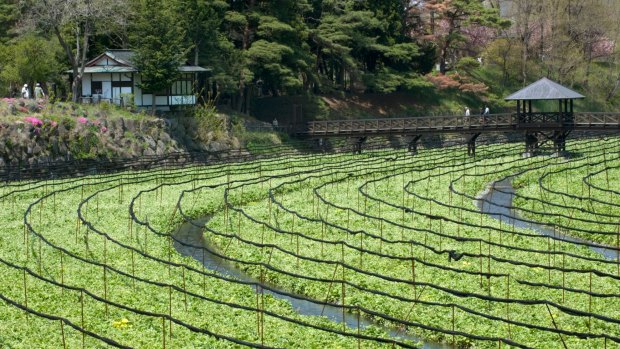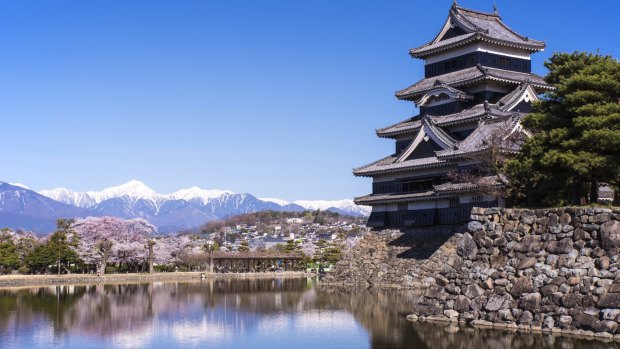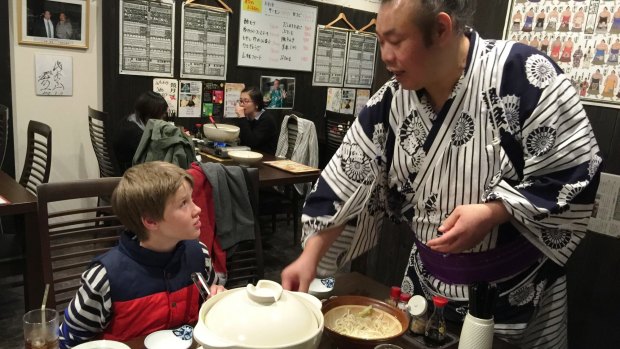This was published 7 years ago
Matsumoto, Japan family cultural holiday: What your kids can learn from Japan
By Max Anderson

A pedestrian bridge crosses wasabi fields at Daio.Credit: Alamy
Is it better to spend money on private school fees or travel?
Debate on private versus public education is complex, but wise heads agree there are "three Ps" that will ultimately affect your child's educational outcome regardless of where they go to school. It's all down to commitment from the principal, the parent and the pupil.
Lately, however, there's been a pointy argument made in favour of public schools, and it too entails a "P": packing a suitcase and taking your child on an overseas trip.

Matsumoto Castle is Japan's oldest castle and a peerless example of 16th-century architecture.Credit: Getty Images
Ex-advertising exec and public school advocate Jane Caro argues that private school fees might be better invested on travel. After taking her daughters on two trips to Europe, Caro said "It was great for the kids to see the history and culture, and experience different languages and ways of life. Those trips were much better value than private school fees. More fun, too."
I have twin boys about to begin year 7, as well as a middle income that will struggle to stay afloat while being shelled by up to $200,000 in school fees. So this is an argument I'm definitely open to.
But I'm also slightly sceptical. Would the fund marked "broadening junior's mind" simply be an excuse for non-fee-paying parents to buy a slightly more expensive holiday than they were going to buy anyway? What sort of travel would offer proper educational horizons?

Jack with ex-professional wrestler Sagami-San, who explains the niceties of shabu shabu (hot pot) at his sumo restaurant in Matsumoto.Credit: Max Anderson
And, most importantly, would junior be open to it – or just a royal pain-in-the-bum?
In October, I had the opportunity to visit Matsumoto in Japan, which has a school exchange program with Australia. I asked Matsumoto Tourism if it could tailor a private tour that properly challenged a 12-year-old boy, moreover an experience that had no swimming pools, no theme parks and no other English-speaking kids.
It said it could. And I knew the perfect pain-in-the-bum to put it to the test.
Meet Jack, an undersized, fair-haired boy who's yet to hit his straps at school, and though 12, still seems a long, long way from teenhood. He is, however, furiously polite and anxious to please with questions. "Have you been to Japan before? Do you like it? I'm really interested in Japan." (A nice lady on the flight to Tokyo has to meet Jack for nine hours.) Actually, his interest in Japan amounts to karate lessons, the mythology of ninjas, a series of books called Samurai Kids and Pokemon cards.
So Tokyo stops him in his tracks. It's large – very large, unrelenting in fact, even at 6am. "I always wanted to see that," Jack says, craning upwards at huge vertical signs of Japanese characters.
I think nothing more of it as we push on to meet our host, Teddy Yamaishi of Matsumoto Tourism. Like many Japanese, Teddy is all patience and kindness, but he has an eye on the clock. Although we landed at 4.50am, there's not a moment to lose on the five-day itinerary and he immediately escorts us three hours north to his relatively small home town.
Matsumoto, population 240,000, sits at the foot of muscular mountains emblazoned with autumn colours. We walk through immaculate narrow streets of 16th-century buildings with odd cross-hatch plasterwork, and Jack is overwhelmed by the otherness of it all. But he senses that we have work to do and, to my surprise, he rises to the occasion and bombards Teddy with questions.
He's curious, for instance, about Japanese bowing. Teddy is happy to give him quick lessons on the formalities, including the Japanese for hello, excuse me and thank you.
"Domo arigato," Jack repeats.
"Don't touch my moustache," Teddy says. Then, smiling at the boy's confusion: "It's the way to remember doitashimashite, which means 'you're welcome'."
At the heart of the town is Japan's oldest castle, a peerless example of 16th-century architecture, with all the curly eaves stacked in a way to suggest the structure is taking flight.
Inside, a student guide named Hiroe accompanies us on the six-storey climb to where the samurai lords once gazed out to the hazed mountains. Jack soaks up the exhibits of weapons and the samurai armour, but he also relishes practising his new Japanese on the lovely young guide – who squeals with delight each time he does so.
Something clicks.
Next day, we drive into the 3000-metre-high mountains where stubborn patches of ice still linger. In the district of Kamikochi we see autumn forests reflected in still lakes under sweet blue skies, an apogee of Japanese aesthetics. I'm fascinated by my first encounter with Japanese wilderness.
Jack, meanwhile, has begun a collection every bit as befuddling as Pokemon cards.
"Teddy, what does this symbol mean?" he asks, pointing to a Kanji symbol on a sign.
"It's hayashi – forest." Jack considers the symbol which resembles two trees standing together. "And if you only see one of the characters, it means tree or wood." At 6am next day, Jack lists his collected Kanji on a page in his journal. Every morning it's the same: we do two hours of writing, stopping occasionally to grab the like of chilled soba noodles, fish and seaweed from the hotel breakfast buffet.
Far from the familiar comforts of Mum's kitchen, we agree that eating will be another adventure. Again, Jack rises to the challenge, and like a Jules Verne hero drilling to the centre of the earth, he stops at nothing.
At Daio, the world's largest wasabi farm where spring water flushes more than 24 hectares of the prized peppery plant, Jack slurps down wasabi ice-cream with barely a hiccup. At the Miyasaka Silk factory, where jellyfish DNA has been inserted into silkworms to make yellow-green silk, he gags on the rather grim byproduct of the squishy silkworms. And at the Sumo-Tei restaurant, owner, host and ex-sumo wrestler Sagami-San is expansive in every way, a performer who looms over Jack instructing him with faux-menace on how to load up the shabu-shabu pot with crab, prawn, fish, tofu and vegetables.
"Sumi masen [excuse me] Sagami-San, I really like your kimono," Jack says.
The giant grins. "Yukata, not kimono," he says. "And this," he smooths the sash around his enormous waist, "is an obi."
More by accident than design, Jack's interests dovetail with history in the mountainous Nagano prefecture around Matsumoto.
In the town of Togakushi, we tour a 17th-century farm now hosting a museum dedicated to 12th-century "Togakure" ninja. The museum exhibits beggar belief. They include exploding walnuts and animal bladders that helped assassins walk on water, but there's enough provenance to show ninjas were rather less than a myth. There's also a three-storey farmhouse which has been re-engineered so you can only move from one room to the next after locating secret doors. Jack is like an insane ferret trying to find sliding panels and trapdoors.
He has to show more restraint before Miyasaka-San who owns a traditional inn, Uotoshi Ryokan, in Udanaka. As well as looking after travellers, Miyasaka-san is a 5th Dan Kyudo master, quiet and well-appraised in the ways of samurai. He shows us into his archery range where we learn the ancient skill of Japanese archery. The remarkable two hours demand a lot of application.
Each day has six or seven appointments. We meet farmers (who also host Australian students) on the outskirts of Matsumoto. We learn how to make soba noodles under a "Soba sensei". We visit the 7th-century Zenko-Ji Temple in Ueda to find the doorway to paradise within a pitch-black tunnel. And in the geothermal pools of Yaen Koen we see the famously serene snow monkeys – serene, that is, when they're not viciously tearing lumps out of each other.
At every opportunity, Jack engages people to practise his Kanji and harvest new words: car (a composite of "automatic wheels"), field, mountain, snow monkey. He's at home with the abstract concept of an ancient language written in pictograms, but can also write his name in Katakana, the phonetic script used for non-Japanese words.
The trip comes to an almost celestial nexus in the 17th-century post town of Narai-juku, one of 69 rest areas along the Nakasendo Highway. Though little more than an earthy footpath through soaring pine trees, the highway once linked Kyoto and Tokyo. Samurais passing through the long narrow wooden street of Narai-Juku would send locals scampering to prostrate themselves. "If you were found to be upstairs in your house you would be looking down on samurai, and could be killed for disrespect," Teddy says. "So upper storeys were only used for storage."
While we stroll between the timber houses and shops, Teddy has to take a phone call, so Jack and I explore a souvenir store. Jack finds a life-size samurai sword made of wood, its handle covered with woven cloth.
"It's a training sword," he says breathlessly. "Can I get it?" I weigh the sword in my hand. "It'll be a nightmare to get through customs. Are you sure it's wood? No steel inside? You'd better check." Jack hurries to the counter, and excitedly gabbles his questions. A small crowd of non-English speakers gathers when it becomes apparent the shop owner also speaks no English.
Jack composes himself, presents the sword and recites his honorifics. Then takes a pen and inscribes three symbols. The Kanji for sword. The Kanji for wood. And a question mark.
I hear the sound of surprise at the sight of a foreign kid writing ancient Kanji. Then shouts of delight because they understand: "Hai! Hai!" they exclaim. "Bok! Bokuto!!" Unsurprisingly, by end of day five the lad is exhausted, and that night excuses himself early at dinner, leaving Teddy and I to share some grown-up time and a little saki.
On returning to my room, I'm taken aback to find Jack wearing a yukata and obi retrieved from the wardrobe – a robe similar to the one he'd admired on the sumo restaurateur. He's practising slow, graceful moves with the wooden sword.
"Finished my journal, Dad," he says.
I'm surprised because I've never seen him looking like this. He looks accomplished.
Getting the bokuto through two stringent sets of airport security and customs is, of course, an absolute pain in the bum. But the sword makes it home.
As does Jack's journal, which becomes a small monument to how much he applied himself, how he put away all the childish things to square up to the task, to stand with me and meet the challenges of a foreign land and a punishing schedule.
And there's another educational outcome. Albeit an unforeseen one.
As much as it forced Jack to apply himself to learning, it forced me to apply myself to Jack. I divested myself of everything that normally consumes me – my wife and my other son Harry, my work deadlines and all the jobs I have to do on the house. I committed myself to spending five days with a young mind that is furiously looking to be filled. As a consequence, Jack grew and he grew and he grew.
It's a lesson well learned, and whether I end up sending my boys to fee-paying school or not, I'd be mad to overlook the returns of a simple three-P formula. One pupil. One parent. And the power of travel to transform.
TRIP NOTES
MORE INFORMATION
welcome.city.matsumoto.nagano.jp/
GETTING THERE
Qantas (www.qantas.com.au) has regular flights to Tokyo from Sydney and Melbourne. See also Jetstar (www.jetstar.com), ANA (www.ana.co.jp) and Japan Airlines (au.jal.com/aul/en/). Australian visitors do not need a tourist visa.
Matsumoto can be reached by express train from JR Shinjuku Station (2½ hours) or by coach from downtown Tokyo (three-plus hours).
STAYING THERE
The Matsumoto REI Tokyu Hotel (www.tokyuhotelsjapan.com/en/hotel/TR/TR_MATUM/index.html) is a central hotel, reasonably priced (by Japanese standards) from about $80 a night; for something more glam (and with a fabulous onsen or hot spring) try the Hotel Shoho (www.japaneseguesthouses.com ) at the foot of the mountains, from $160 a night.
SEE + DO
Matsumoto Tourism can arrange private guides to the city and surrounds, however self-driving in Japan is surprisingly easy; all major hire car companies are represented.
Max Anderson was a guest of Matsumoto Tourism. Jack's tour was also hosted but his flights were paid privately.
Sign up for the Traveller Deals newsletter
Get exclusive travel deals delivered straight to your inbox. Sign up now.